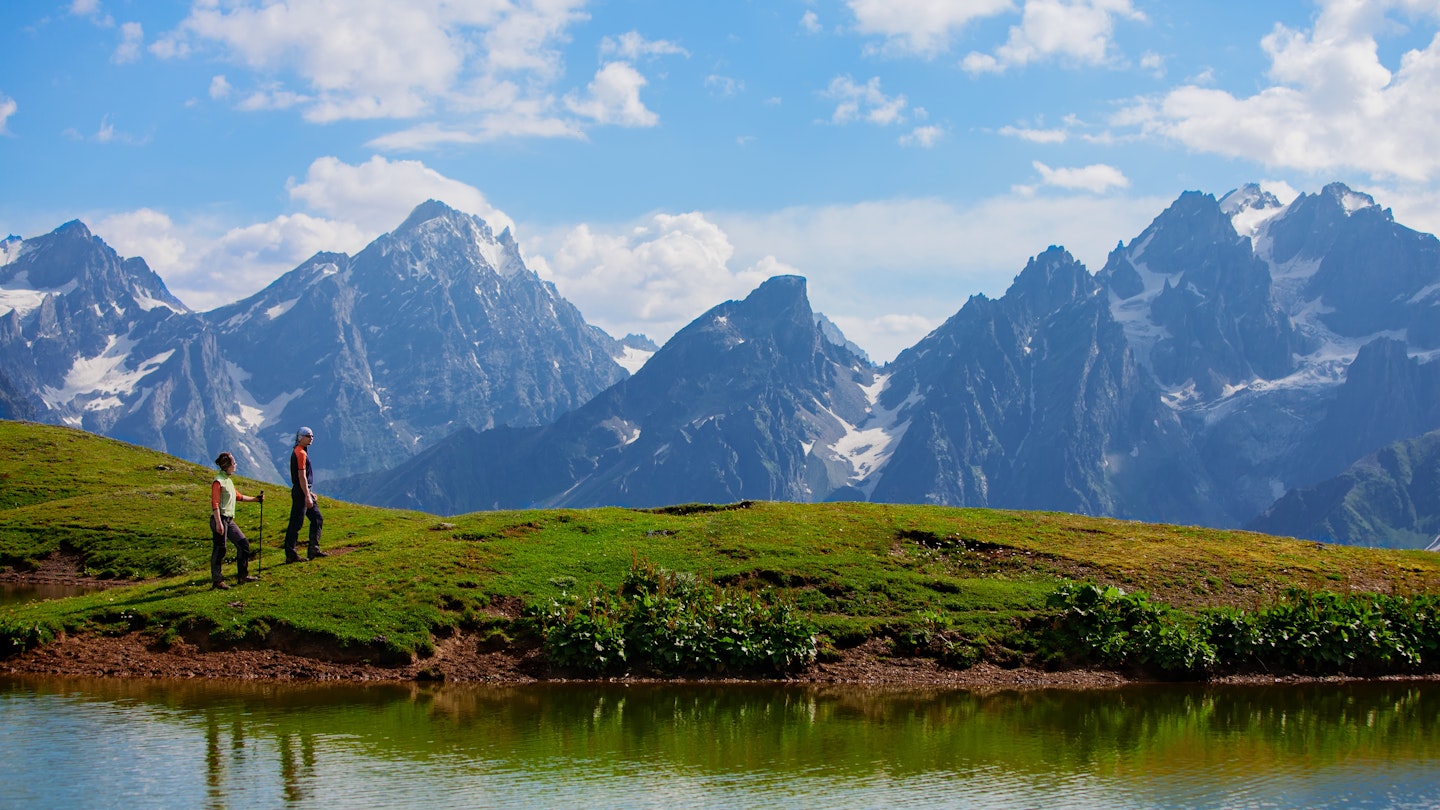Discover the Majestic Mountains of Georgia
Beyond wine, hospitality, and Stalin, Georgia conjures up images of majestic mountains. Soaring peaks are fronted by timeless highland tower-house villages. Only 20 years ago, the stunning regions of Khevsureti, Tusheti, and Svaneti were considered danger zones. Today, they are a paradise for hikers.
Why Georgia?
Europe’s highest mountain range is not the Alps—it is, in fact, the Greater Caucasus. While the tallest peaks over 5000m are on the Russian side of the border, Georgia’s highlands are not far behind.
Georgia is visa-free for citizens of most countries (including members of the EU, the UK, USA, Australia, and New Zealand) and roads into the mountains from the marvellously quirky capital Tbilisi are improving.

One-Day Walks
It’s no surprise that more travellers are discovering Stepantsminda, a small town often referred to by its old name Kazbegi, where an iconic church punctuates a skyline backed by the dazzling 5033m-high Mt Kazbek. Hiking routes abound, and if you’re looking for quick yet spectacular hiking opportunities, day walks from Kazbegi or nearby Juta are excellent options.
Multiday Treks
One of the region’s great appeals, however, is the possibility of multiday treks between isolated village homestays. Now that geopolitical problems between Georgia and its breakaway regions of South Ossetia and Abkhazia have calmed down, the attractive concept of the TransCaucasian Trail, which follows the mountains between the Black and Caspian Seas, has come to life. Several hundred kilometers of the trail have already been built by teams of volunteers, and more routes through the mountains are still under construction. Certain classic sections of this route feature paths that are well-trodden yet still exude an otherworldly remoteness.
The top choices for multiday treks lie in the spectacular Svaneti province or between the equally beautiful Tusheti region and the brooding stone citadel of Shatili. Both options enhance incredible scenery with an extra ‘secret weapon’—the koshkebi.

Koshkebi Towers
At Tbilisi’s excellent Open Air Museum of Ethnology, you can see a gently tapered stone tower high on the hillside overlooking the rest of the site’s relocated village houses. Austere, spindly, and almost cartoon-like with minimal windows and a machicolated top-knot, this is one of the koshkebi, the tower houses that give many of Georgia’s mountain villages their unique look.
The remote regions of Tusheti and Svaneti are speckled with villages dominated by these captivating koshkebi towers. They provide extraordinary foregrounds for breathtaking landscapes, representing the tumultuous history of mountain peoples who are fiercely proud of their independence from outsiders. Due to the remoteness of their settlements and the impenetrability of their fortresses, invaders would often bypass these areas rather than attempt to conquer them.
The exact age of these towers remains unknown. Ushguli, a community of four villages in Georgia’s Upper Svaneti region, is listed as a World Heritage Site, although even UNESCO has refrained from determining the age of their defensive structures, indicating that their origins “go back to prehistory.”

Choosing Between Svaneti and Tusheti
Choosing between Svaneti and Tusheti is a significant question for most hikers, as the long and bone-rattling journey between the two areas complicates visiting both. Svaneti likely wins overall for the sheer magnificence of the mountainscapes and the magic of the koshkebi at Ushguli. Nonetheless, with dozens of guesthouses, Mestia—the main town in Svaneti—can feel larger and more ‘discovered’ than some visitors anticipate.
Although there’s a narrow seasonal window for visiting Tusheti, hikers find immense satisfaction walking from village to tower-house village, staying in timeless stone houses in Dartlo, Girevi, and Ardoti during a five-day crossing to Shatili via the Atsunta pass. A tent is required for one night in the middle section, and couple of river crossings can be a bit daunting early in the season. Fortunately, finding a guide with a horse upon arriving in Tusheti is usually possible, allowing you to have your bags carried and hop onto the saddle for those brief water crossings.
Safety During Your Trek
In the 1990s, there were legitimate reasons to hesitate before visiting Georgia’s high mountain regions. Svaneti was notorious for kidnappings, and the historic citadel of Shatili in Khevsureti was reputedly a hideout for ruthless Chechen separatists from Russia, compounded by atrocious road access to the highlands.
However, things changed significantly after 2004, as the new president Mikheil Saakashvili’s government restored order. Today, the main dangers comprise unpredictable mountain cows and an abundance of hospitality: if approached by a large man carrying a Kalashnikov, he is likely to offer you several glasses of chacha, a sort of Georgian grappa made from discarded grape skins. Therefore, it’s essential to learn the toast in Georgian: Sakartvelos Gaumarjos! (Here’s to Georgia!).
Getting There
Since 2013, a new asphalted road provides easy access to Mestia, and the previously horrendous track leading to Ushguli is steadily improving.
For Khevsureti and Tusheti, it’s crucial to note that both regions are entirely snowbound for much of the year. Remarkably, many resilient citizens in Shatili remain in their blizzard-bound homes year-round, while the entire population of Tusheti, including the Tolkienesque town of Omalo, relocates by the end of September to the Kakheti lowlands, returning around May or June. When the road is open, shared jeeps to Shatili run several times a week, and chartering a ride isn’t difficult as long as you’re flexible. The same applies for the winding, unpaved route to Omalo, with chartered 4WDs readily arranged from Telavi or Alvani.
This article was first published in August 2017 and was last updated in March 2020.





